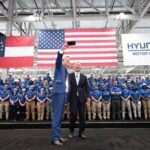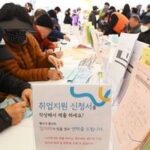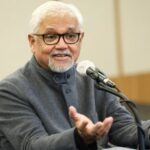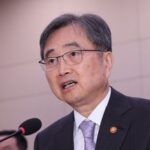![韓 독자 ‘핵무장’ 필요 없나…국민 73%가 ‘찬성’ vs 尹 “NPT(핵확산금지조약) 준수가 국익”[이현호 기자의 밀리터리!톡]](https://contents-cdn.viewus.co.kr/image/2024/02/CP-2023-0094/image-457e9fbd-09bf-4ee9-8b82-f6989db12431.jpeg)
Amid escalating North Korean nuclear threats, seven out of ten Koreans believe that South Korea needs to develop nuclear weapons independently, according to a survey.
According to the results of a “public opinion survey on the perception of the North Korean nuclear crisis and security situation,” conducted on 1,043 adults aged 18 years and older by Gallup Korea at the request of the Chey Institute for Advanced Studies on December 15 last year to 10th of the previous month, 51.4% responded “somewhat agree” and 21.4% “strongly agree” to the question of whether South Korea needs to develop nuclear weapons independently. The response that nuclear weapons are required reached 72.8%. Although this is about 4%p lower than last year, it is still a high level of support.
There was little deviation in opinion on nuclear armament according to political inclination, and a high level of support was shown in the lower income bracket.
The most effective countermeasure against North Korean nuclear threats was the strengthening of South Korea’s nuclear potential (20.6%), followed by US nuclear sharing similar to NATO (20.4%), strengthening of the Korean style triaxial system (18.7%), and redeployment of tactical nuclear weapons on the Korean Peninsula (16.2%).
91.1% No to ‘Is it possible to denuclearize North Korea’
Notably, 49.7% responded that North Korea can’t denuclearize in a situation where North Korea has legalized a nuclear preemptive strike. 41.4% also said “not at all possible.” This pessimistic response rate (91.1%) is higher than last year (77.6%). This is interpreted as a strong perception that North Korea’s denuclearization is impossible, forming a high consensus on the need for South Korea’s own nuclear armament.
Moreover, it was found that the opinion that the strengthening of cooperation among the three countries of Korea, the United States, and Japan, which the current government presents as the basis for opposing its nuclear armament, is not sufficient to remove North Korea’s nuclear threat is dominant. In a survey asking whether the North Korean nuclear threat would be resolved due to the strengthening of security cooperation, such as the three-nation summit held at Camp David in the United States last August, the pessimistic responses of “no (53%)” and “not at all (10.4%)” reached 63.5%.
Park In Kook, President of the Chey Institute for Advanced Studies (former ambassador to the UN), analyzed, “The overall perception of the people revealed in this survey shows that the strengthening of extended deterrence on the Korean Peninsula in the direction that Korea’s direct participation is guaranteed is urgent.”
![韓 독자 ‘핵무장’ 필요 없나…국민 73%가 ‘찬성’ vs 尹 “NPT(핵확산금지조약) 준수가 국익”[이현호 기자의 밀리터리!톡]](https://contents-cdn.viewus.co.kr/image/2024/02/CP-2023-0094/image-584eaa20-45ca-4d1d-bb59-246fa9aac738.jpeg)
Just as the public is concerned about North Korea’s nuclear threat, North Korea continues to show off its nuclear power.
In April last year, North Korea unveiled a tactical nuclear warhead, “Hwasan-31.” The Korean Central News Agency reported that Kim Jong Un, the North Korean leader standing in front of the lined-up nuclear warheads, instructed to expand the production of “powerful nuclear weapons.” This is the first time North Korea has exposed the actual nuclear warhead. However, only the warhead, assumed to be a boosted fission bomb, and the warhead, claimed to be a hydrogen bomb, were revealed.
The tactical nuclear warhead that was revealed is estimated to be about 50 cm in diameter. North Korean media released photos of Chairman Kim receiving reports from officials in front of the neatly lined-up nuclear warheads. The phrases “Hwasan-31 mounted nuclear warheads” and “600mm super-large-caliber artillery nuclear warheads” are exposed in the photo.
Chairman Kim argued, “We should continue to produce powerful nuclear weapons by expanding the production of weapons-grade nuclear materials prospectively” and “When our powerful and superior nuclear force takes on an offensive posture, the enemy would fear us and cannot dare to touch our sovereignty, system, and people.”
Estimate of North Korea’s Nuclear Weapons Stockpile: 20-90
While the estimates vary depending on the expert or institution, the current number of nuclear weapons North Korea possesses is estimated to be between 20 and 90. In this situation, Kim Jong Un ordered at the 6th plenary meeting of the 8th Central Committee of the Workers’ Party to “increase the number of nuclear warheads exponentially.” In response, North Korea is believed to be continuously producing nuclear weapon materials as secret high-enriched uranium facilities continue to operate actively.
According to a report titled “North Korea’s Nuclear Arsenal-New Estimates” published by the Institute for Science and International Security (ISIS), a US private research institute specializing in nuclear disarmament, North Korea is estimated to have 45 nuclear weapons. The report predicted that as of the end of 2022, the number of nuclear weapons North Korea could have made is between 35 and 65, with a median value of 45.
North Korea is believed to have achieved significant results not only in the number of nuclear weapons it possesses but also in miniaturizing tactical nuclear warheads that can be mounted on various missiles. The Hwasan-31 type is the smallest nuclear warhead North Korea has ever revealed, with a 40-50 cm diameter and a length of about 90 cm. It is believed that the nuclear warhead can be mounted on eight types of weapons, including the KN-23 “North Korean version of Iskander” missile, 600mm super-large-caliber artillery, unmanned underwater attack craft “Haeil,” Arrow-1·2 long-range cruise missile, KN-24 missile, “Mini” submarine-launched ballistic missile (SLBM), and new tactical missile.
![韓 독자 ‘핵무장’ 필요 없나…국민 73%가 ‘찬성’ vs 尹 “NPT(핵확산금지조약) 준수가 국익”[이현호 기자의 밀리터리!톡]](https://contents-cdn.viewus.co.kr/image/2024/02/CP-2023-0094/image-373c242b-0dd9-4175-8e75-1355c9228771.jpeg)
The Yoon Suk Yeol government is stepping back from South Korea’s independent nuclear armament. Essentially, the policy is that the extended deterrence (nuclear umbrella) provided by the United States is sufficient for South Korea.
President Yoon stated in a special interview on the 7th that regarding the suggestion of “nuclear armament” from some quarters, he said, “Considering our country’s technological capabilities, if we set our minds to it, we can say that it won’t take long (to develop nuclear weapons).” Experts believe that South Korea can develop and deploy nuclear weapons within 2-3 years.
President Yoon also emphasized, “When comprehensively assessing national operations, strictly adhering to the NPT (Treaty on the Non-Proliferation of Nuclear Weapons) is more in line with national interests.” The NPT regime prohibits non-nuclear-weapon states from acquiring nuclear weapons. He further stated, “If we were to develop nuclear weapons now, we would probably face various economic sanctions similar to North Korea” and “Our economy would suffer serious consequences.”
However, contrary to President Yoon’s stance, according to a survey by the Chey Institute for Advanced Studies, an overwhelming majority of South Korean citizens (60.8%) answered negatively to the question of whether they believe the United States will exercise nuclear deterrence in a situation similar to the Korean War. This is a 12.1 percentage point increase from last year’s 48.7%. The Academy analyzed that this change is not so much due to a decrease in South Koreans’ trust in the United States but rather to the heightened sophistication of North Korea’s nuclear weapons development and its widened provocative posture.

Some argue that if independent nuclear armament, which is considered to have more drawbacks than benefits like President Yoon’s stance, is deemed problematic, then the plan to rearm with nuclear weapons, similar to that of the United Kingdom, could be a realistic alternative. It is proposed that this could be integrated into the U.S. military bases in South Korea, following the example of modernizing facilities at the Lakenheath Royal Air Force Base in the UK as the most effective means of deterring North Korea’s nuclear threats.
Recently, the United States has been pursuing the redeployment of nuclear weapons to the United Kingdom for the first time in 15 years. The plan involves modernizing facilities at the Lakenheath Royal Air Force Base and deploying the latest tactical nuclear weapons, such as the B61-12. Initially, the Lakenheath base had 33 underground facilities deployed with 110 units of B-61 series tactical nuclear bombs in the 1990s, but all tactical nuclear weapons were withdrawn in 2008.
The logic is to modernize or retrofit nuclear weapons storage facilities within Osan and Gunsan Air Bases, where the U.S. Forces deployed tactical nuclear weapons in the past, or to construct nuclear weapons storage facilities at dozens of large and small U.S. military bases across the country, like the UK example, deploying direct nuclear weapons on the Korean Peninsula. Simultaneously, it proposes deploying U.S. tactical nuclear weapons in a manner of rotation, temporary deployment, or fixed deployment to more effectively deter North Korea’s nuclear threats.
US, UK push to modernize nuclear storage facility at air force bases
Joh Bi Yeon, a senior researcher at the Korea Institute for Defense Analyses (KIDA) and an expert in extended deterrence, stated in the 2022 “Exploring Alternatives to the NATO Nuclear Sharing Arrangement” (KIDA Brief Security No. 8) that “even without permanently deploying tactical nuclear bombs, the United States could temporarily deploy nuclear weapons in case, through the modernization of past storage facilities, thus demonstrating the cohesion of the alliance and a firm commitment to deterrence.” She argued that this could contribute to making it difficult for adversary countries to calculate gains and losses, similar to China’s construction of missile silos across the country to increase strategic ambiguity about the actual locations of nuclear weapons.
Joh emphasized that if past nuclear weapons storage facilities at U.S. military bases in South Korea were modernized, it could produce a “balance of terror” effect similar to deploying U.S. tactical nuclear weapons. The explanation is that “flexible deployment of tactical nuclear weapons,” which involves redeploying U.S. tactical nuclear weapons on the Korean Peninsula in case, could mitigate the burden on both the U.S. and South Korea regarding the redeployment of tactical nuclear weapons and enhance strategic flexibility and deterrence.

The United States’ recent actions are aimed at containing Russia. Last June, Russia deployed its own tactical nuclear weapons in Belarus. This marked the first time since the collapse of the Soviet Union in 1991 that Russia deployed nuclear weapons outside its own territory.
At that time, President Putin said it was “the same as what the United States has done,” mentioning the deployment of tactical nuclear weapons by the United States in five NATO countries, including Belgium, Germany, Italy, the Netherlands, and Turkey.
Amidst the controversy surrounding independent nuclear armament, Russia has repeatedly warned against North Korea’s 7th nuclear test, escalating military tensions on the Korean Peninsula.
Aleksandr Matsegora, the Russian ambassador to North Korea, was quoted by the Russian Sputnik News on the 10th local time as saying that if the United States continues its provocations, North Korea cannot rule out the possibility of conducting a nuclear test.
In an interview with Sputnik, Ambassador Matsegora stated, “If U.S. provocations continue and if they become increasingly dangerous, I cannot rule out the North Korean leadership’s decision to conduct nuclear tests to enhance their national defense capabilities.”
He further stated, “This is clearly not a desirable scenario,” and “But if this happens, the responsibility will lie entirely with the United States and its allies.”
Ambassador Matsegora had previously stated in an interview with the Russian TASS news agency on the 7th that if the United States continues its provocative moves in the region, North Korea may decide to conduct additional nuclear tests.















Most Commented